
There are many substantive critiques of Nagle’s reactionary anti-immigration article out there (see here, here, here, here, here, here and here) but I want to take a closer look at her use and abuse of history to further her arguments in favour of immigration restrictionism.
It’s beyond historical debate that racism was a central motivation which led to white labour movements demanding that the State enact, and then enforce, the Chinese Exclusion Act (1882) and its equally racist legal successors. Yet the reclamation of this history is now required as the centrality of the racism behind this immigration law was at times erased and diminished in Angela Nagle’s recent anti-immigration article “The Left Case Against Open Borders”.
Nagle’s obscurantism and historical negationism attempts to assassinate the memory of an overtly ethno-nationalist immigration law for political and ideological purposes, namely in the service of her argument that European and American labour movements should ignore the “moral blackmail” of so-called “immigration expansionists” and instead embrace nationalism and immigration restrictionism. Unsurprisingly this article has been subsequently promoted by far-right ideologues and commentators such as Ann Coulter, VDARE, Steve Sailer, Kevin McDonald, Tucker Carlson, Richard Spencer & co.
The article’s historical negation of the Chinese Exclusion Act, and the racism which powered it, was achieved in a number of ways.
- The deliberate decision to not refer to this racist law by its name. This is all the more striking when even her likely source for this line of argument named it and was up front about its inherent racism. Nagle’s tactical anonymisation of the Chinese Exclusion Act distorts the historical record and is akin to referring to the Nuremberg Laws as “the citizenship laws of 1935” and just moving on from there without comment.
- This historically illiterate article misrepresents the significance of this law in the history of racism and racial exclusion in the U.S. by ahistorically referring to it as merely being the “the first law restricting immigration in 1882.” This is incorrect. There were many restrictive and discriminatory U.S. immigration laws that preceded the Chinese Exclusion Act (both federal and national) and they stretch back to the seventeenth century colonial period. The significance of the Chinese Exclusion Act is that it was the first national immigration law in U.S. history that banned an entire group of people, based on their race or ethnicity, from migrating to the United States. It’s notable that a self-described writer of the “Left” would not seem to be aware that some of the common forms of immigration control up to the 1880s (and beyond) were classist and that they overwhelmingly discriminated against the poor. As immigration historian Hidetaka Hirota has noted, these laws were “based on the model of the English poor law, which allowed each parish to banish transient beggars, English colonists developed similar practices to regulate the movement of the poor. When the famine Irish arrived in the United States during the 1840s, nativists in Massachusetts and New York built upon the colonial poor laws to develop laws for restricting the landing of destitute foreigners and deporting immigrant paupers back to Europe. Throughout the era of state-level immigration control between the 1840s and 1880s, the Irish remained principal targets for these measures.” Nagle’s immigration restrictionism puts her to the right of the nativist Know Nothing party, who were more concerned with the naturalization/political power of the foreign-born population than restricting migration based on geography, prejudice and “race”.
- The economic self-interest of these white labour movements, expressed through their segregationist policies and sometimes violent racism, is framed as “sometimes” “intermingling” with rational, economic and strategic responses to “mass migration” rather than a case of it being primarily fueled by fear, xenophobia, prejudice and nativist myths which inhibited basic worker solidarity. When Nagle does admit that “union opposition to mass migration was sometimes intermingled with racism” she plays it down as a secondary issue and couches it in moral relativism as she adds in parentheses that racism was in any case “present across American society.” This is a minimisation tactic. The following comparison should not be necessary to drive home this point, but imagine for a moment if it was argued that the Nuremberg Laws were “intermingled” with anti-semitism but that this anti-semitism was in any case “present across German society.”
- In introducing this unnamed “immigration law of 1882” she then immediately conflates it with the United Farm Workers’ (UFW) opposition to the use of undocumented workers as strikebreakers in the 1960s, thus again minimising the racism of white labour movements who supported the Chinese Exclusion Act in the 1880s. While the Chinese Exclusion Act is stripped of its very name and purpose, Nagle’s stresses how the UFW was “famously multiethnic.” Imbalanced and deceptive writing like this is not journalism or history, it’s straight up propaganda.
That so many labour movements in the U.S. supported the Chinese Exclusion Act and yet refused to support abolitionism is historical evidence of American labour union complicity with nationalism, ethno-statism and the politics of racism. This use of collective bargaining for racist, white supremacist ends, essentially a sort of herrenvolk unionism, demands reflection, not championing. In 1915 Lenin described such nativist labour movements in the U.S. that supported racist immigration laws as “jingo-socialism”, but perhaps he was just another “virtuous identitarian” to be sneered at.
Nagle’s negationism and moral relativism in the service of immigration restrictionism is all the more striking in light of the fact that Nagle is an Irish commentator who moves between Ireland and the U.S. unhindered, including on one occasion where she crossed the border to interview a far-right propagandist who wants to ethnically cleanse America of non-white people. Her historical illiteracy is shown by her ignoring the context for the racist history of U.S. immigration laws which were partly rooted in a 1790 naturalization law limiting citizenship to “free white persons”. Irish “mass migration” to the U.S. in the 19th century numbered in the millions yet never led to racial essentialist immigration laws preventing ingress from Ireland. To this day this is what underpins far-right ideology against non-white immigration and explains why their objections are always on the basis of the “assimilability” of the migrant.
Most pertinent of all is the responsibility that Irish historians, journalists and commentators have to know and respect the history of this anti-Asian racial exclusion. This basic responsibility arises from the fact that a number of the most influential political and labour leaders who supported or drafted anti-Asian immigration laws in U.S. were first and second generation Irish Americans.
“The Chinese Must Go”
Denis Kearney, an Irish immigrant from Co. Cork, was one of the most infamous and racist anti-Chinese labour leaders in the U.S. in the 1870s. Kearney founded the Workingmen’s Party of California and his motto was “the Chinese must go”. For decades he agitated for the imposition of anti-Chinese legislation and threatened to “drive the Chinese into the sea” if they did not leave voluntarily. He stated that he hoped to live long enough” to see the Asiatic hordes excluded from this continent from Cape Horn to Icy Cape.” In 1892 he turned his attention to Japanese migration and in The Sun newspaper declared that “when the American people hear what I have to say on this question of flooding out country with inferior races who cannot become citizens, they will make such a demand that Congress must exclude the Jap, the same as it excluded his pig-tailed rat-eating cousin, the Chinaman….I want my [grandchildren] protected. I don’t want to have them competing in the labor market with an inferior race.”
“The Chinese evil”
The Knights of Labor (KOL) organisation were one of the most vocal labour movements in favour of the Chinese Exclusion Act. The head of the KOL at this time was Terence Powderly, a son of Irish immigrants who migrated to the U.S. in the late 1820s. Powderly referred to Chinese migration as the “Chinese evil” and claimed that they
“Never adapt themselves to our habits, modes of dress or our educational system; they carry their pagan idolatry into every walk in life…[they] see no difference between right and wrong..”
But much worse than this was his discussion of the Rock Springs Massacre of 1885 where at least 28 Chinese miners were murdered by white miners. He initially condemned this mass murder as an “act of inhumanity and butchery” but then proceeded to rationalise the violence. He engaged in victim-blaming and pointed the “look what you made us do” finger at the U.S. government for not being more stringent in enforcing their racist laws. He then justified all of this with another effusion of anti-Chinese racism.
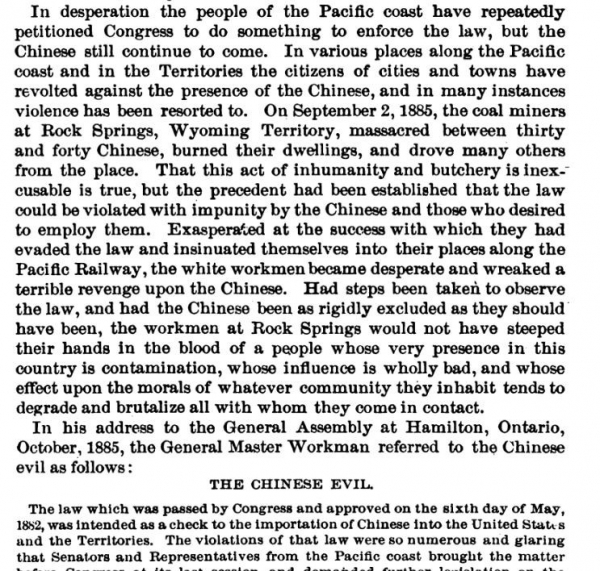
The Geary Act (1892)
Then there is Congressman Thomas J. Geary who wrote in 1893 that Chinese immigrants “establish no domestic relations here, found no homes, and in no wise increase or promote the growth of the community in which they reside.” Geary’s parents were Irish immigrants. He wrote the Geary Act (1892) which extended the Chinese Exclusion Act (1882) for ten more years. It also made it law that effectively all Chinese people resident in the U.S. had to carry special registration cards. Failure to produce a card would mean arrest and deportation. An exception was included whereby a “credible white witness” could vouch a Chinese person who did not have a card due to “accident, sickness, or other unavoidable cause”. Many in the Chinese community in the U.S. resisted this law by refusing to register.
“California is white man’s country”
He was followed by Senator James D. Phelan, who was a former Mayor of San Francisco (1987–1902). Phelan, like Geary and Powderly, was a second generation Irish American. In 1901 he published an article entitled “Why the Chinese should be excluded” which included a whole range of racist tropes about Chinese people.
“The Chinese, by putting a vastly inferior civilization in competition with our own, tend to destroy the population, on whom the perpetuity of free government depends.”
In 1906 Phelan was interviewed by the Sunday Herald where he warned of a “silent invasion” of Japanese migrants.
They must be excluded because they are non-assimilable; they are a permanently foreign element; they do not bring up families; they do not support churches, schools, nor theatres; in time of trial they will not fight for Uncle Sam, but betray him to the enemy. They now occupy valleys in California by lease or purchase of land to the exclusion of not only whites but Chinese, and if this silent invasion is permitted by the federal government, they would at the rate at which they are coming, a thousand a month, soon convert the fairest state in the union into a Japanese colony. If they were naturalized they would outvote us. But California is white man’s country, and the two races cannot live side by side in peace, and inasmuch as we discovered the country first and occupied it, we propose to hold it against either a peaceful or a warlike invasion.
In 1917 the Asiatic Barred Zone was included in that year’s Immigration Act. All who lived in this geographic area were barred from migrating to the United States and this racist law (and subsequent laws in 1921 and 1924) had the strong backing of the American Federation of Labor. The commissioner general suggested extending the “barred zone to such parts of Asia as are not now included therein nor affected by exclusion laws or agreements, and also to Africa and adjacent islands, so as to exclude inhabitants who are of unassimilable classes or whose admission in any considerable number would tend to produce an economic menace to our population.”
Overall Nagle’s essay was not against “open borders” per se, that’s merely the pretext, it’s function is a critique of immigration along labour market/competition lines. This is made clear by her reference to “immigration expansionists” who use the “powerful weapon” of “moral blackmail and public shame”. She takes right wing positions on immigration throughout the piece but tries to cloak it by disclaiming that the ill-treatment of undocumented migrants by private citizens is a concern. What is omitted here is that she wants the State to deal with undocumented workers by not letting them in or by forcing employers to fire them. No need to get your hands dirty, just call the cops.
Nagle uses a reactionary lexicon throughout her article, putting nativism in scare quotes but writing “illegal”, “mass migration” and “labor importation” without interrogation — all the while, and despite her disclaimers, striping migrants of their agency, reduced to pawns of big business. In an impressive display of callousness, migrants’ advocates are referred to as “useful idiots of big business.” She hypocritically engages in her much lamented “virtuous identitarianism” by bringing up her Irish identity, but solely to talk about the outward migration of Irish citizens. There is silence about immigration to Ireland and the segregation and striping of labour rights of asylum seekers stuck in our deliberately punitive Direct Provision system.
Her inclusion of various strawman arguments, so many of which could easily be drawn directly from anti-immigration lobby groups, also distorts this history. For instance she name drops Karl Marx and Frederick Douglass in a botched attempt to smear the current Left as being shallow and intolerant. These historical figures are misused by Nagle as examples of 19th century leaders who, she claims, would be described as “anti-immigrant” by today’s “virtuous identitarians”. The problem is that Marx was an internationalist who wanted to abolish nation-states. He called for class solidarity between Irish immigrant workers and the English working class, not the enforcement of borders.
“This antagonism [between Irish migrants and the English] is artificially kept alive and intensified by the press, the pulpit, the comic papers, in short, by all the means at the disposal of the ruling classes. This antagonism is the secret of the impotence of the English working class, despite its organization. It is the secret by which the capitalist class maintains its power. And the latter is quite aware of this.”
Her Frederick Douglass appropriation is equally nonsensical. Douglass was a liberal who famously criticised anti-Chinese jingoism in 1869 and was literally in favour of open borders.
“I submit that this question of Chinese immigration should be settled upon higher principles than those of a cold and selfish expediency. There are such things in the world as human rights. They rest upon no conventional foundation, but are external, universal, and indestructible. Among these, is the right of locomotion; the right of migration; the right which belongs to no particular race, but belongs alike to all and to all alike. It is the right you assert by staying here, and your fathers asserted by coming here. It is this great right that I assert for the Chinese and Japanese, and for all other varieties of men equally with yourselves, now and forever. I know of no rights of race superior to the rights of humanity, and when there is a supposed conflict between human and national rights, it is safe to go to the side of humanity…I reject the arrogant and scornful theory by which they would limit migratory rights, or any other essential human rights to themselves, and which would make them the owners of this great continent to the exclusion of all other races of men.”
Ilya Somin, a Professor of Law at George Mason University, noted in 2014 that “some immigration restrictionists like to cite Douglass’ statements decrying many employers’ preferences for white immigrant labor over black labor, and state governments’ giving white immigrants voting rights that were denied to blacks. Neither of these positions, however, is equivalent to supporting legal restrictions on immigration, which Douglass opposed for the reasons noted above.”
This method of attack on her nameless critics is similar to the anti-“woke tumblr teen” juvenalia found in her other work and these rhetorical sleights of hand, through the misuse of history, are microcosms of Spiked/Living Marxism style reactionary contrarianism. Writers in the Spiked/Living Marxism orbit are partly defined by their historical illiteracy, but also by their unerring ability to drive left wing individuals and groups to distraction. Professional contrarians. In 2017 the editor of Spiked Brendan O’Neill appropriated a speech made by Frederick Douglass to defend the “free speech” right of Nazis and far-right organisations to recruit on university campuses. A contrarian to the core, O’Neill did not mention that the context for Douglass’ speech was his condemnation of pro-slavery forces who broke up an anti-slavery meeting in Boston. Nagle, meanwhile, appropriated Douglass to use him as a prop amidst her argument, as Patrick Blanchfield has put it, “in favour of barbed wire”.
Researchers at Libcom.org have identified the likely root source for Nagle’s use of Douglass et al. in the service of anti-immigration arguments, namely an article that was published by the Center for Immigration Studies (CIS), a “low immigration, pro-immigrant” think tank, in 1996. In 2016 the SPLC listed CIS as a “an anti-immigrant hate group [for] its repeated circulation of white nationalist and antisemitic writers in its weekly newsletter and the commissioning of a policy analyst who had previously been pushed out of the conservative Heritage Foundation for his embrace of racist pseudoscience.” The CIS was founded by the white nationalist and eugenicist John H. Tanton in 1985.
This alignment with CIS propaganda is also shown through her conflation of the undocumented migrants who were granted legal status by Reagan in 1986, with neo-liberalism and capital generally, thus framing their legalization as a net negative. Or as she puts it a “neo-liberal attack on the national barriers that control the flow of labour”. Thus these millions of workers are to her but a vast strike-breaking force legalised by a neo-liberal government to undermine the native worker by driving down wages, rather than the strengthening of the labour bargaining position, rights and protections of the most vulnerable workers in the U.S. as well as placing them on the path to citizenship if they so desired it.
She begins her article by conflating the UFW’s opposition to the use of undocumented workers as strikebreakers in the 1960s with undocumented migrants generally (a popular piece of anti-immigration propaganda) and then equates this with the racism of white labour movements who supported the Chinese Exclusion Act in the 1880s, declining to discuss how the UFW supported Reagan’s amnesty bill. Professor Steven W. Bender, author of the article “César Chávez” for the Oxford Bibliographies in Latino Studies, has noted how nativists have simplistically appropriated Chávez as a poster boy against illegal immigration to mock immigration reformists. Bender addresses the controversy as follows
Chávez recognized the hypocrisy of INS immigration officials, who would look the other way to protect farmers when they employed undocumented workers as labor strikebreakers, but would deport the workers once the crops were picked or if they joined the UFW strike. Chávez alleged the Nixon administration and the growers conspired to limit immigration enforcement in the fields, so long as the migrants were useful to the growers, in the ongoing cycle of the invitation and exile of Mexican workers seen by too many US employers as implements rather than as humans…
On the subject of mass deportation, Chávez wrote in a 1974 editorial of the San Francisco Examiner that the UFW opposed the mass deportation of undocumented immigrants, most of them from Mexico. Rather, Chávez advocated amnesty and supported immigrant efforts to obtain lawful status and equal rights, including the right to unionize. While resisting their use as strikebreakers — who the union opposed regardless of their migration or citizenship status, Chávez urged federal immigration reform to allow current undocumented migrants to gain protection as legal residents in their employment and everyday lives.”
The co-founder of the UFW, the legendary Dolores Huerta, made a similar point about the nuance of Chávez’s stance in an interview with Fusion.
Dolores Huerta Schools Us on Cesar Chavez’s Views of Undocumented Immigrants
Some people say that civil rights leader Cesar Chavez was fiercely opposed to undocumented migrant labor. There is…fusion.tv
When asked last year what the single most impactful success of the UFW was, Huerta emphasised how “farmworkers — even if they’re undocumented — are covered by the minimum wage laws of the nation. They’re also covered by worker safety laws, [so they] can’t be forced to work in places that might endanger their health or their safety. And the [1986] amnesty bill was a big one…”. After the passage of this law about 1 million farmworkers became legal U.S. residents.
But the complexity of this history if of no use to Nagle, so a moment in time is cherry picked for maximum effect, echoing the anti-immigrant propaganda of the Center for Immigration Studies (CIS) who created a “border control” Chávez meme (see below) in March 2018.

That same month the executive director of the CIS, Mark Krikorian, wrote an op-ed for the right-wing pro-Pinochet National Review magazine which recommended that Americans should “honor the Farm Workers leader’s 90th birthday with National Border Control Day”. The white nationalist Fox News presenter Tucker Carlson then used this National Review/CIS article as the basis for a Prager video published in October 2018. This video also stressed Chávez’s opposition to the use of undocumented workers as strikebreakers, but falsely conflated it with undocumented workers in general. Many members of the UFW at this time were themselves undocumented workers, which is, of course, not mentioned by Kirkorian, Carlson or Nagle.
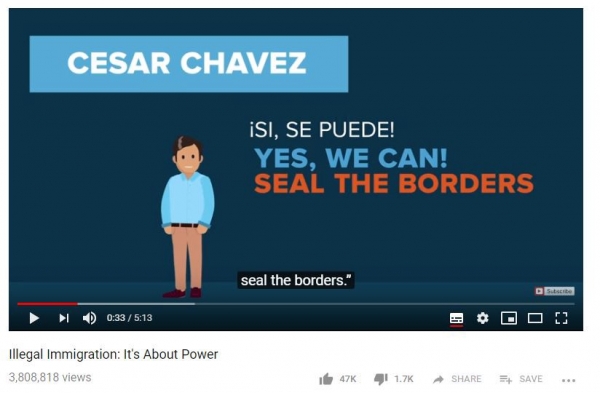
Like Nagle, Carlson’s propaganda ignored the UFW’s more progressive position over the last four decades in favour of legal amnesty for undocumented workers. So I guess there were no prizes for guessing which Fox News show Angela Nagle was on promoting her reactionary views just a few days after publishing her article.
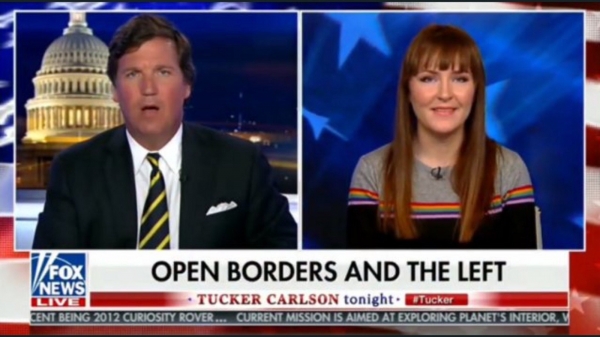
Nagle’s concern about a “Brain Drain”, a profoundly eugenicist concept, is also a common anti-immigration talking point. The Federation for American Immigration Reform (FAIR) were pushing this angle of attack at least as far back as 2002.
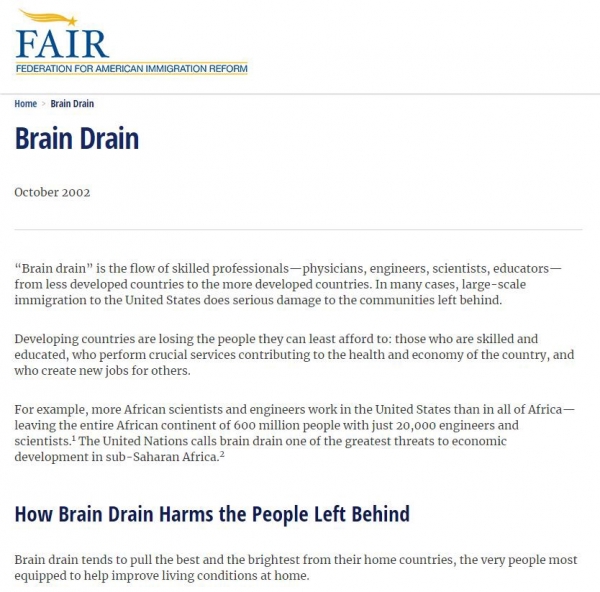
Who are FAIR?
FAIR was founded by the aforementioned white nationalist and eugenicist John H. Tanton in 1979 and “between 1985 and 1994, FAIR received around $1.2 million in grants from the Pioneer Fund”. Indeed the well-worn white nationalist trope of the “The Immigration Invasion” is the title of a 1994 book by Tanton and he also published the racist French novel “The Camp of the Saints” multiple times in the U.S. This book is a core text for contemporary neo-fascists and ethno-nationalists in the U.S. and in Europe.
What Nagle and FAIR both omit from their concerns about “the brain drain” is the amount of remittances that are sent back to migrants’ families in developing countries. According to the UN this amounted to an estimated $480 billion in 2017. In lieu of “full employment” in social utopias of perfect governance, where everyone is happy and persecution, inequality (global and domestic) do not exist, the concern about the effect of “ the brain drain” on developing countries is often but a “virtue signalling” mask for anti-immigration politics.




















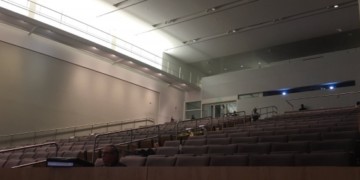

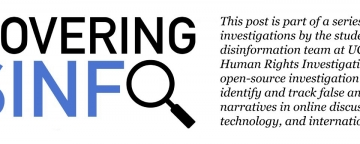





Connect with us